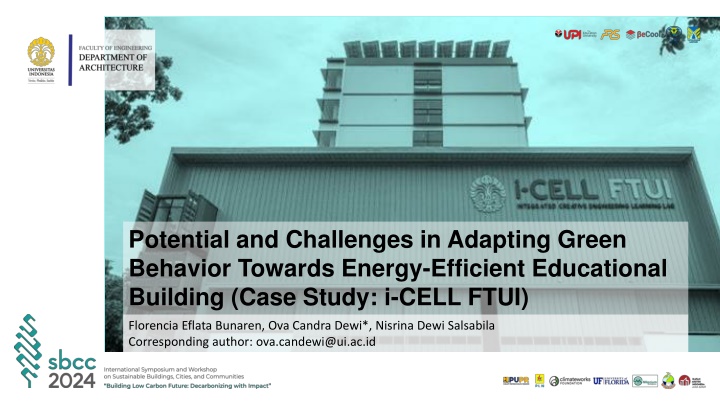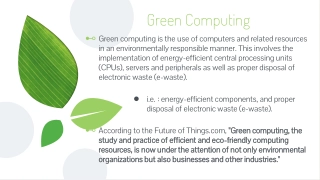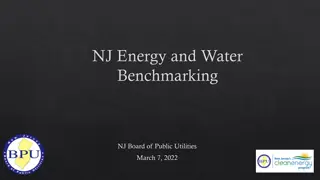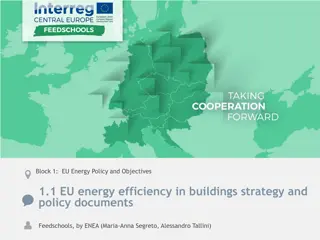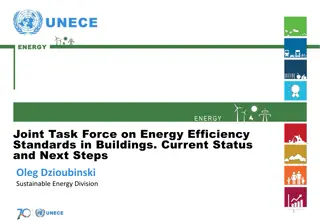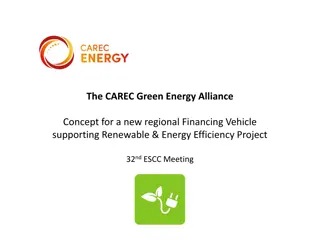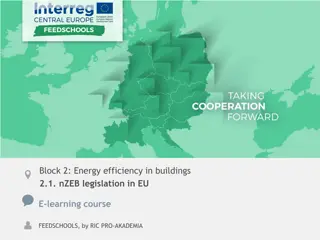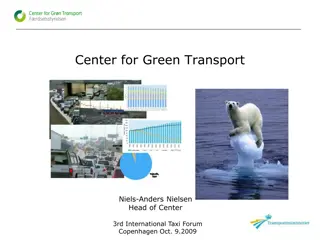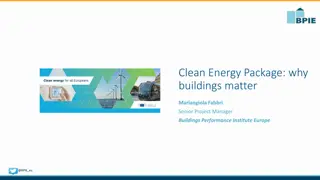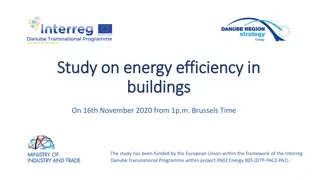Adapting Green Behavior for Energy-Efficient Educational Buildings
Examining the potential and challenges in adapting green behavior towards energy efficiency in educational buildings, focusing on the case study of i-CELL FTUI. The study looks at factors influencing energy consumption, technical and human aspects of green building, and potential energy savings through behavioral changes. Various strategies for reducing energy usage in educational buildings are explored, highlighting the importance of user behavior in promoting sustainability.
Download Presentation

Please find below an Image/Link to download the presentation.
The content on the website is provided AS IS for your information and personal use only. It may not be sold, licensed, or shared on other websites without obtaining consent from the author.If you encounter any issues during the download, it is possible that the publisher has removed the file from their server.
You are allowed to download the files provided on this website for personal or commercial use, subject to the condition that they are used lawfully. All files are the property of their respective owners.
The content on the website is provided AS IS for your information and personal use only. It may not be sold, licensed, or shared on other websites without obtaining consent from the author.
E N D
Presentation Transcript
Potential and Challenges in Adapting Green Behavior Towards Energy-Efficient Educational Building (Case Study: i-CELL FTUI) Florencia Eflata Bunaren, Ova Candra Dewi*, Nisrina Dewi Salsabila Corresponding author: ova.candewi@ui.ac.id
Introduction Factors in Building s Energy Consumption Green behavior is where every individual consciously minimizes the negative impact of their actions on the environment, one of which is by saving energy (Kollmuss & Agyeman, 2002). Green Behavior in Green Building Technical Green Behavior 20% Architectural design, passive and active systems The i-CELL FTUI has received EDGE Green Building certification with an energy efficiency of 70%, assessed based on the technical aspects (EDGE, 2022; Maudisha, 2022). Habits, discipline, awareness Green Building Human 80% This study examines user behavior regarding electrical energy consumption in green buildings (ESDM., 2011) Potential and Challenges in Adapting Green Behavior Towards Energy-Efficient Educational Building (Case Study: i-CELL FTUI) | Florencia Eflata Bunaren, Ova Candra Dewi, Nisrina Dewi Salsabila
Materials & Method Potential energy savings that occur in green buildings through green behavior Equipment Plug load Green Behavior Use more efficient equipment/devices Turn off equipment/devices when not in use Change desktop management by setting times to dim the screen, turn off the screen, and enter sleep mode Reduce screen use when working on a computer/laptop Reduces the brightness of the computer/laptop screen Control User Ref [1; 2; 3] Energy Saving Potential through behavior Total Energy Saving Potential Building Type Turning off electrical equipment Source Turning light on/off Turning off AC 59% by Users (+ use a more efficient lighting system) 34% by Users (+ efficient temperature regulation) 34% by Users (+ reduction of internal load) Educationa l building [1] 39% Light switch Turn the lights on/off according to use User [2; 4] [2] [5] 17.8% by Users (+ turn on the light manually, then the light automatically turns off after 10 minutes) HVAC Stairs and Elevator Thermostat Green Building Technology Building Energy Management System (BEMS) Turn the AC on/off according to use Use stairs instead of elevator User User Smart building in a university [2] (NA) (NA) (NA) Set the thermostat to 24 C-26 C Green Maintainability on building equipment Monitoring and controlling energy consumption for low energy use, low carbon emissions, maintaining environmental conditions. Managers Managers [2] [6] 4,6% - 12,6% by Managers (+ turn on the AC 2 hours before work time until home time) Managers [7] 26.1% - 51,7% by Users (+ utilize natural lighting) Office building 11% - 28.4% by Users (NA) [3] Adapted from: [1] Almeida, et al.,2020; [2] Loengbudnark, et al., 2022; [3] He, et al., 2021 [1] Gandhi & Brager, 2016; [2] He, et al., 2021; [3] Azizi, et al., 2015; [4] Loengbudnark, et al., 2023; [5] Xie, et al., 2020; [6] Asmone & Chew, 2016; [7] Yang, et al., 2017 Potential and Challenges in Adapting Green Behavior Towards Energy-Efficient Educational Building (Case Study: i-CELL FTUI) | Florencia Eflata Bunaren, Ova Candra Dewi, Nisrina Dewi Salsabila
Materials & Method Figure 1. Knowledge, Norms, and Perceived Behavioral Control of building users and managers for green behavior Knowledge Knowledge Norms Norms Perception of Control Perception of Control Environmental knowledge more accurate Environmental knowledge more accurate user interaction with buildings user interaction with buildings (Balvedi, 2018). Perception is stimulated by internal and Perception is stimulated by internal and external motivations external motivations (Li et al., 2020). Present because of the pressure that is felt Present because of the pressure that is felt significant by the individual significant by the individual (Greaves et al., 2013). Manager Manager Knowledge Knowledge 1 1. . Internal Internal Motivation Interest, belief, responsibility and sense of accomplishment in environmental protection (Liao et al., 2021). Motivation 1 1. . Social Social Norms Norms Operation and maintenance on green building technology assets (ifma.org) Descriptive Descriptive norm Reflection of the behavior of people who are considered important (Gao et al., 2017). norm Theory of Planned Behavior Respond to feedback from users (Grover., 2019). Subjective Subjective norm There is pressure from other people who feel important (Gao et al., 2017). norm 2 2. . External External Motivation External motivation consists of rewards or punishments (Priyankara et al., 2018). Motivation In relation to green behavior, an individual s behavioral beliefs are affected by their knowledge of the building s system and awareness of the effects of their actions towards the environment. User User Knowledge Knowledge Awareness that human actions impact the environment (Sabri et al., 2022). Enforcement of energy saving behavior (Fachrudin et al., 2021). 2 2. . Personal Personal moral moral norms norms Act according to morals (de Groot et al., 2021). A written approach that guides the user (Shin et al., 2019). Based on his responsibility and moral obligation (Gao et al., 2017). Figure 2. Potential and Challenges in Adapting Green Behavior Towards Energy-Efficient Educational Building (Case Study: i-CELL FTUI) | Florencia Eflata Bunaren, Ova Candra Dewi, Nisrina Dewi Salsabila
Materials & Method Data Collection Data Analysis Discussion Literature Study Energy saving potential through Green Behavior Case Study Energy consumption of the i- CELL FTUI Building Potential of Behavioral Changes towards Green Behavior in Building Users Potential of Energy saving in i-CELL Building through Green Behavior Variables comparison Current Green Behavior Questionnaire Willingness to conduct Green Behavior Potential of Behavioral Changes towards Green Behavior in Building Managers i-CELL Building Users i-CELL Building Managers Challenges in implementing Green Behavior for Building Users Knowledge Norms Challenges in implementing Green Behavior for Building Managers Perception of Control Potential and Challenges in Adapting Green Behavior Towards Energy-Efficient Educational Building (Case Study: i-CELL FTUI) | Florencia Eflata Bunaren, Ova Candra Dewi, Nisrina Dewi Salsabila
Energy Result and Discussion from the Building Users Energy Consumptio n in i-CELL (kWh) Savings Potential by Implementing Green Behavior (based on literature review) Consumption if Green Behavior is Implemented (kWh) Savings Percentage in i- CELL Building Usage Cooling Interior Lighting Interior Equipment 13305.07 34% [1] 59% [1] 8781.34 965.427 Current Green Behavior Indicator I practice energy-saving behavior in Green Building Willingness to Conduct Green Behavior Indicator I am willing to change my habits for a more energy- efficient building even if it takes extra effort I am willing to spend some time to learn about energy-efficient behavior and its benefits I am willing to turn off the air conditioner when not in use 2354.70 26.1 - 51.7% [2] 34% [1] 11 - 24.8% [2] 1137.32 - 1740.12 4108.39 4681.07 - 5540.10 13855.15 - 16061.56 Mean Mean 6224.83 3.872 (Agree) 4.000 (Agree) 21884.6 26.60 - 36.55% I opt to use energy- efficient electrical equipment 4.217 (Strongly Agree) 4.012 (Agree) Adapted from: [1] Almeida, et al.,2020; [2] He, et al., 2021 4.564 (Strongly Agree) 4.730 (Strongly Agree) I turn off AC when I leave the room The results show higher average scores for the willingness questions compared to each respective current question, as well as higher total average (from 3.948 to 4.417). Thus, it can be concluded that users are highly willing to improve their behavior to promote energy savings in green building. 3.692 (Agree) 4.346 (Strongly Agree) I turn the light on/off according my needs I am willing to turn off the lights when not in use I unplug my equipment (computer, handphone, etc.) when the battery is full or the equipment is not in use The biggest energy saving can be achieved through interior lighting controls, such as turning off the lights when not in use. Cooling energy can also be reduced if the users had been given more control of the AC in their respective working rooms. Building users also consent to increase energy savings through control of personal equipment. 4.576 (Strongly Agree) I am willing to unplug the equipment when not in use 3.821 (Agree) 4.417 (Strongly Agree) 0.717 3.948 (Agree) Total Mean Total Mean Standard Deviation 1.0806 Standard Deviation Potential and Challenges in Adapting Green Behavior Towards Energy-Efficient Educational Building (Case Study: i-CELL FTUI) | Florencia Eflata Bunaren, Ova Candra Dewi, Nisrina Dewi Salsabila
Energy Consump tion in i- CELL (kWh) Savings Potential by Implementing Green Behavior (based on literature review) Energy Savings Percentage in i-CELL Building Consumption if Green Behavior is Implemented (kWh) Result and Discussion from the Building Managers Usage 11628.63 - 12693.04 965.427 1137.32 - 1740.12 4108.39 4681.07 - 5540.10 16702.45 19973.26 Cooling 13305.07 4.60 - 12.60% [2] Current Green Behavior Indicator Willingness to Conduct Green Behavior Indicator I am willing to spend time to study the operational and maintenance for electrical systems towards an energy-efficient building I am willing to spend time to study the operational and maintenance for lighting systems towards an energy-efficient building I am willing to spend time to study the operational and maintenance for cooling systems towards an energy-efficient building I am willing to maximize the green building potential in energy consumption through changing the user behavior Interior Lighting 59% [1] Mean Mean 2354.70 26.1 - 51.7% [2] I maximize the potential of usage and conduct maintenance to the electrical equipment in green building regarding energy consumption I maximize the potential of usage and conduct maintenance to the lighting equipment in green building regarding energy consumption I maximize the potential of usage and conduct maintenance to the cooling equipment in green building regarding energy consumption I conduct environmentally friendly operations and maintenance management towards energy efficient building 3.889 (Agree) 4.333 Interior Equipment 34% [1] 11 - 24.8% [2] (Strongly Agree) 6224.83 3.889 (Agree) 4.222 8.73 23.67% 21884.6 (Strongly Agree) Adapted from: [1] Almeida, et al.,2020; [2] He, et al., 2021 3.778 (Agree) 4.222 (Strongly Agree) Improvements in behavior of the managers are not as high as the users , indicated by the total average which only rises from 4.028 to 4.160. Additionally, score reduction was also found in questions regarding monitoring and controls of lighting and electrical equipment. 4.000 (Agree) 4.000 (Agree) I am willing to conduct evaluation and improvements of the existing SOP towards a more energy-efficient building through user behavior I am willing to invite other users to conduct energy saving behavior I am willing to monitor the use of AC occasionally and turn off the AC in empty rooms I am willing to monitor the use of lighting occasionally and turn off the lights in empty rooms I am willing to monitor the use of plugs occasionally and unplug the equipment when not in use 4.111 (Agree) Similar to the users, the biggest energy saving can be achieved through interior lighting controls. However, the controls for interior lighting inside of each room should fall more to the building users instead of the managers. Similar results were also found in terms of personal equipment, where building managers are less likely to take control of electrical equipment in each room. 4.000 (Agree) 4.111 (Agree) I encourage building users to conduct energy-saving behaviors I overwatch the usage of AC on rooms being used, and turn off the AC if the room is not being used I overwatch the usage of lights on rooms being used, and turn off the lights if the room is not being used I unplug the building s electrical equipment if not in use by the users 3.889 (Agree) 4.111 (Agree) 4.444 4.111 (Agree) (Strongly Agree) Cooling energy can also be reduced by the managers, although the savings are not as high compared to if the controls were given to building users. 4.333 4.222 (Strongly Agree) (Strongly Agree) 4.028 (Agree) 0.667 4.160 (Agree) 0.601 Total Mean Total Mean Standard Deviation Standard Deviation Potential and Challenges in Adapting Green Behavior Towards Energy-Efficient Educational Building (Case Study: i-CELL FTUI) | Florencia Eflata Bunaren, Ova Candra Dewi, Nisrina Dewi Salsabila
Conclusion Green behavior in energy consumption by building users has the potential to provide a significant reduction in energy consumption compared to managers. Green behavior by users of the building could save 26.60%-36.55% of the energy consumption, whereas behavior by building managers only saved 8.73%-23.67%. However, the role of managers is also important in reducing electrical energy consumption because they play a role in maintaining equipment. In achieving this potential savings, there are challenges that must be overcome from the user or manager, and also from the relationship between the two. Users face a challenge of a lack of awareness of the types of efficient electrical equipment and the inability to control air conditioners. Managers face a challenge in the lack of knowledge and perception of control over electrical equipment in green buildings. Managers have encouraged users to adopt green behavior in consuming electrical energy, but the appeal was still not felt by users. For further studies, other dimensions can be added regarding the amount of savings through simulation. Potential and Challenges in Adapting Green Behavior Towards Energy-Efficient Educational Building (Case Study: i-CELL FTUI) | Florencia Eflata Bunaren, Ova Candra Dewi, Nisrina Dewi Salsabila
